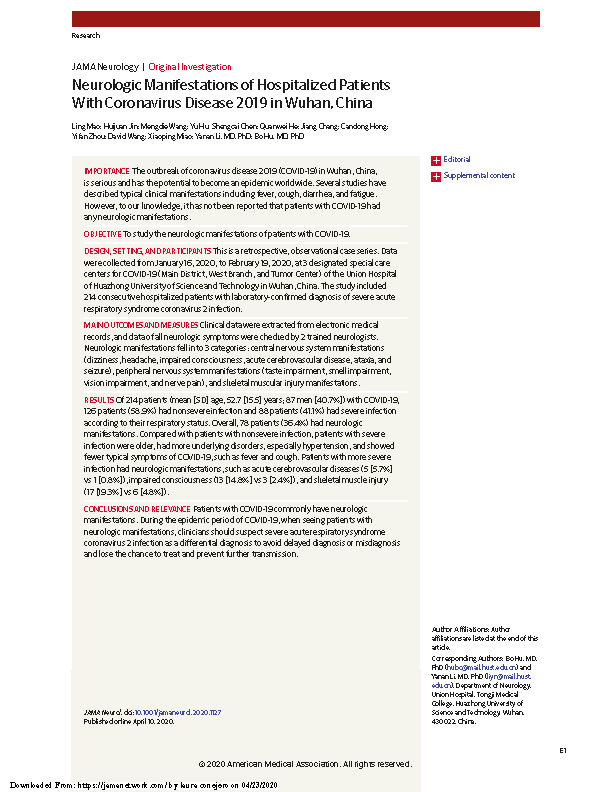Apr 23 Neurological Manifestations of Hospitalized Patients With Coronavirus Disease 2019 in Wuhan, China
Ling Mao, Huijuan Jin, Mengdie Wang, Yu Hu, Shengcai Chen, Quanwei He, Jiang Chang, Candong Hong, Yifan Zhou, David Wang, Xiaoping Miao, Yanan Li, Bo Hu
ABSTRACT
Importance: The coronavirus disease 2019 (COVID-19) outbreak in Wuhan, China is serious and has the potential to become a worldwide epidemic. Several studies have described the typical clinical manifestations including fever, cough, diarrhea, and fatigue.
However, to the best of our knowledge, patients with COVID-19 have not been reported to have any neurological manifestations.
Objective: Study the neurological manifestations of patients with COVID-19.
Design, setting and participants: This is a case series of retrospective observation. Data were collected from January 16, 2020 to February 19, 2020 at 3 special care centers designated as COVID-19 centers (Main District, West Branch, and Tumor Center) at Union Hospital of the University of Science and Technology in Huazhong in Wuhan, China. The study included 214 hospitalized patients with a laboratory-confirmed diagnosis of coronavirus 2 infection.
Main results and measures: Clinical data were extracted from electronic medical records. Data for all neurological symptoms were verified by 2 expert neurologists.
Neurological manifestations were classified into 3 categories:
- Central nervous system manifestations (dizziness, headache, impaired consciousness, acute cerebrovascular disease, ataxia and seizures),
- Peripheral nervous system manifestations (taste disturbance, smell disturbance, vision impairment, and nerve pain)
- Manifestations of skeletal muscle injury.
Results: Of 214 patients (mean [SD] age, 52,7 [15,5] years; 87 men [40,7%]) with COVID-19, 126 patients (58,9%) had non-serious infection and 88 patients ( 41,1%) had severe infection according to their respiratory status.
- Overall, 78 patients (36,4%) had neurological manifestations compared with patients with non-severe infection.
Compared with patients with non-severe infection, patients with severe infection:
- they were older
- Had more underlying disorders, especially hypertension
- They showed fewer typical symptoms of COVID-19, such as fever and cough.
Patients with more severe disease had more neurological manifestations, such as:
- acute cerebrovascular diseases (5 [5.7%] vs 1 [0.8%])
- Altered consciousness (13 [14.8%] vs 3 [2.4%])
- Skeletal muscle injury (17 [19,3%] vs 6 [4,8%]).
Conclusions and relevance: Patients with COVID-19 commonly have neurological manifestations. During the epidemic period of COVID-19, when seeing patients with neurological manifestations, clinicians should suspect severe acute respiratory syndrome due to coronavirus 2 infection as a differential diagnosis to avoid diagnosis delays or misdiagnosis and miss the opportunity to treat and prevent a higher transmission.



